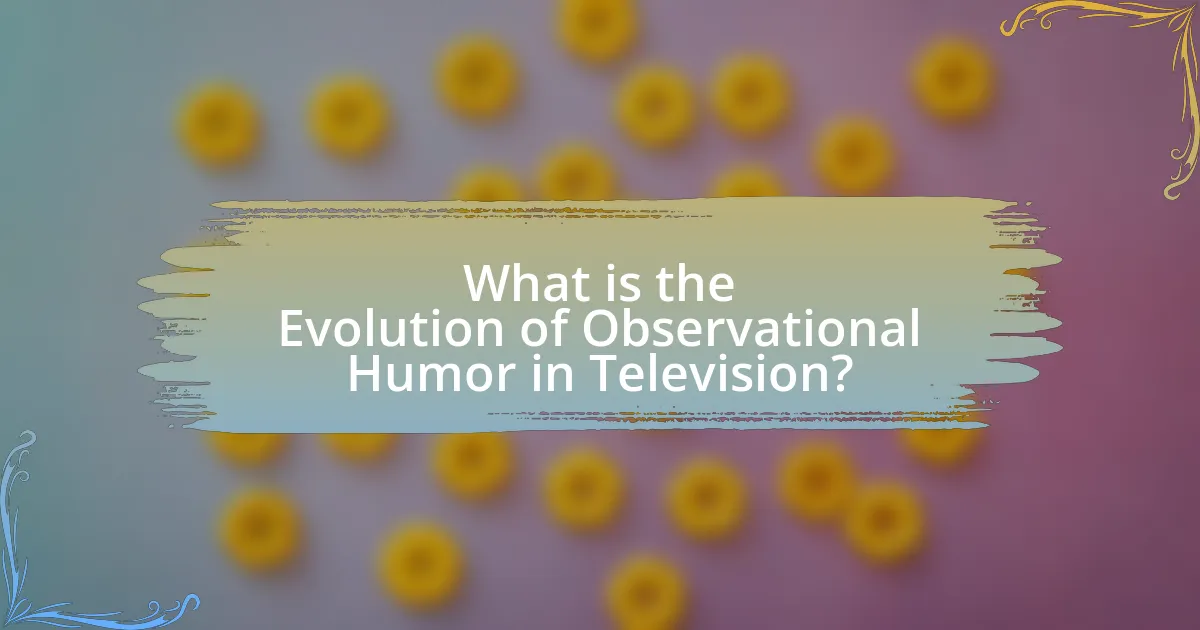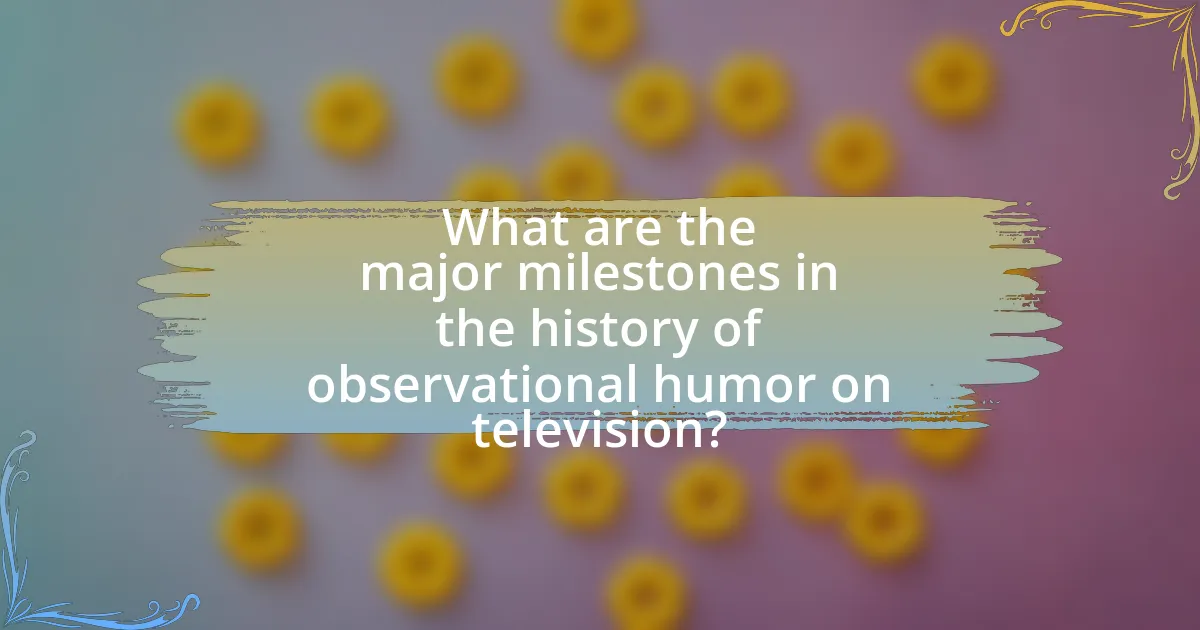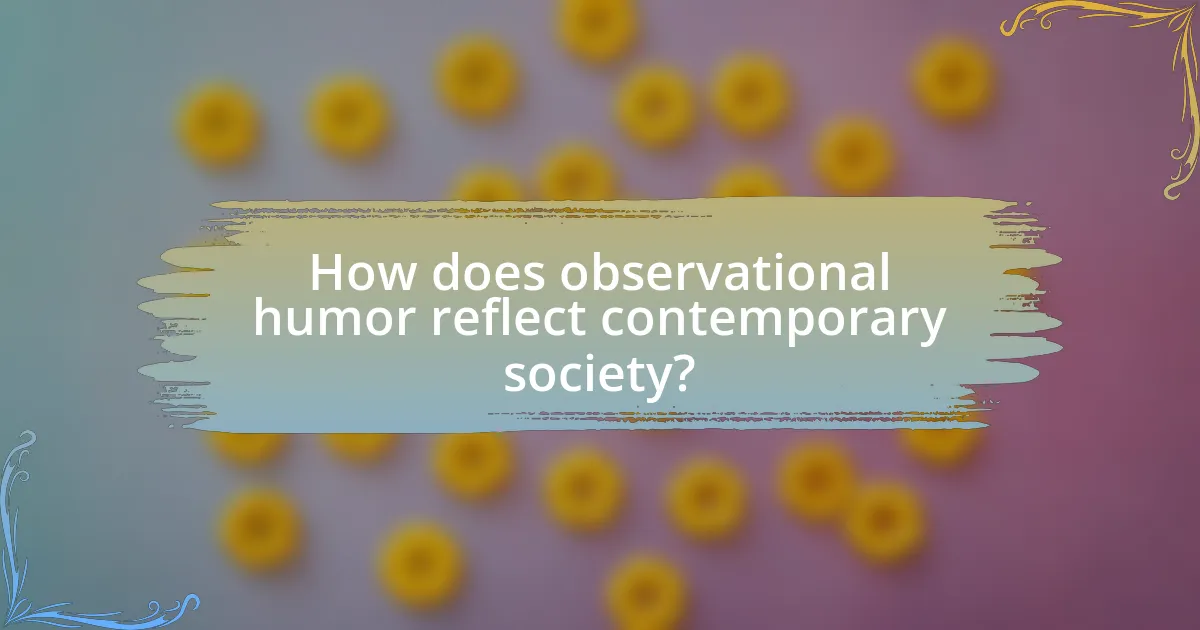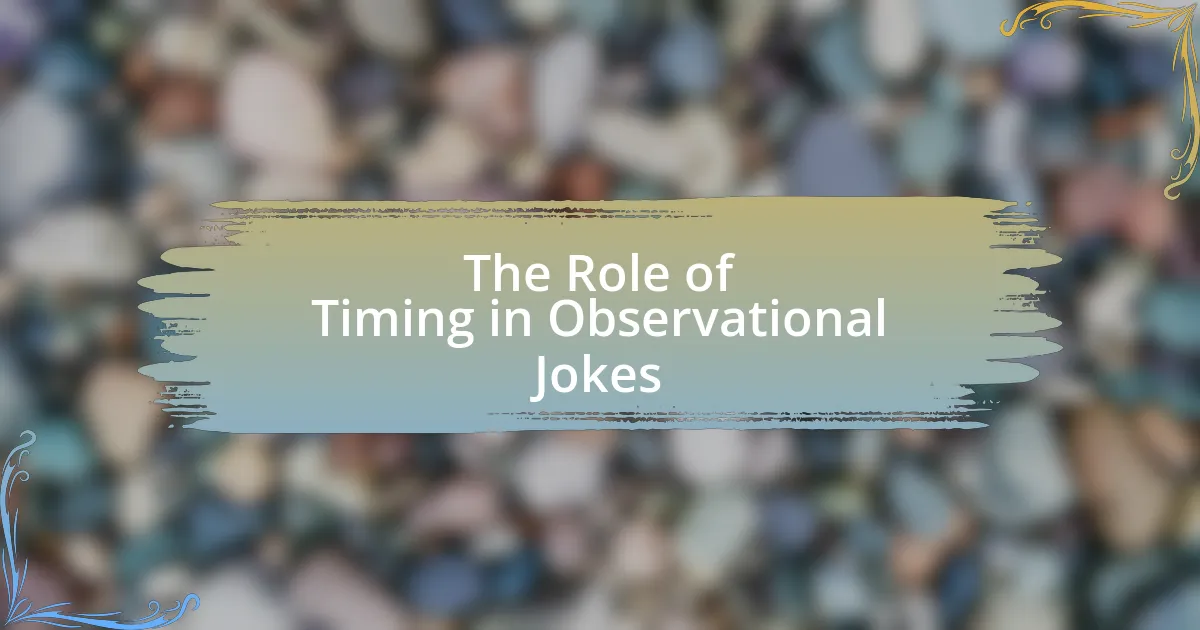The article examines the evolution of observational humor in television, tracing its origins from the 1950s with shows like “The Honeymooners” to its refinement in the 1990s with “Seinfeld” and its modern adaptations in series such as “The Office” and “Parks and Recreation.” It highlights how societal changes and cultural shifts have influenced the genre, emphasizing the importance of relatability and diverse perspectives in contemporary comedic narratives. Key milestones, defining characteristics, and the impact of influential comedians are discussed, illustrating how observational humor reflects and critiques everyday life and social norms. The article also explores techniques for creating effective observational humor tailored to different audiences.

What is the Evolution of Observational Humor in Television?
The evolution of observational humor in television began in the 1950s with shows like “The Honeymooners,” which highlighted everyday life and relationships through comedic situations. This style gained prominence in the 1970s with “All in the Family,” where social issues were tackled through humor, reflecting real-life experiences and societal norms. The 1990s saw a further refinement with “Seinfeld,” often dubbed a “show about nothing,” which focused on the minutiae of daily life, emphasizing the absurdity in mundane situations. By the 2000s, series like “The Office” and “Parks and Recreation” utilized a mockumentary format to enhance observational humor, blending character-driven narratives with relatable scenarios. This progression illustrates how observational humor has adapted to cultural shifts and audience expectations, maintaining relevance through its focus on the human experience.
How has observational humor changed over the decades?
Observational humor has evolved significantly over the decades, shifting from broad, relatable themes to more nuanced and specific cultural commentary. In the 1970s and 1980s, comedians like George Carlin and Richard Pryor focused on societal norms and personal experiences, often addressing universal topics such as relationships and daily life. By the 1990s, comedians like Jerry Seinfeld popularized a more refined style that emphasized the minutiae of everyday situations, leading to the rise of sitcoms that centered around observational humor, such as “Seinfeld” itself.
In the 2000s and beyond, the genre has incorporated diverse perspectives, with comedians like Ali Wong and Hasan Minhaj addressing issues of race, gender, and identity, reflecting a broader societal awareness. This shift is evidenced by the increasing representation of various cultural backgrounds in comedy, which has expanded the scope of observational humor to include experiences that resonate with a wider audience. The evolution of platforms, such as social media and streaming services, has also allowed for more immediate and varied expressions of observational humor, enabling comedians to engage with current events and trends in real-time.
What were the key influences on the early forms of observational humor?
The key influences on the early forms of observational humor include social commentary, everyday life experiences, and the comedic styles of vaudeville and stand-up comedy. Social commentary provided a framework for comedians to reflect on societal norms and behaviors, allowing them to highlight the absurdities of daily life. Everyday life experiences served as relatable material, enabling audiences to connect with the humor on a personal level. Additionally, the comedic styles of vaudeville and stand-up comedy laid the groundwork for observational humor by emphasizing timing, delivery, and the importance of personal anecdotes. These influences collectively shaped the development of observational humor, making it a staple in television comedy.
How did societal changes impact the development of observational humor?
Societal changes significantly influenced the development of observational humor by reflecting the evolving norms, values, and everyday experiences of the population. For instance, the rise of suburban living in the post-World War II era led to a focus on domestic life and family dynamics in comedic narratives, as seen in shows like “The Dick Van Dyke Show,” which highlighted relatable situations in a typical household. Additionally, the civil rights movement and shifts in gender roles during the 1960s and 1970s prompted comedians to address social issues and challenge stereotypes, as exemplified by “All in the Family,” which tackled racism and sexism through humor. These societal transformations provided a rich context for observational humor, allowing it to resonate with audiences by mirroring their realities and concerns.
What are the defining characteristics of observational humor?
Observational humor is characterized by its focus on everyday life and relatable experiences. This type of humor often highlights the absurdities and quirks of mundane situations, making it accessible to a wide audience. Comedians like Jerry Seinfeld exemplify this style by drawing attention to common occurrences, such as waiting in line or the intricacies of social interactions, which resonate with viewers. The effectiveness of observational humor lies in its ability to reflect shared human experiences, allowing audiences to connect through laughter over familiar scenarios.
How does observational humor differ from other comedic styles?
Observational humor differs from other comedic styles by focusing on everyday experiences and relatable situations, often highlighting the absurdities of daily life. This style contrasts with other forms of comedy, such as slapstick or situational comedy, which rely more on physical humor or exaggerated scenarios. For instance, comedians like Jerry Seinfeld exemplify observational humor by drawing attention to mundane topics, such as waiting in line or the quirks of social interactions, making them universally relatable. This approach allows audiences to connect with the humor on a personal level, as it reflects shared experiences rather than relying on fictional or exaggerated narratives.
What role does relatability play in observational humor?
Relatability is crucial in observational humor as it allows audiences to connect personally with the content, enhancing their enjoyment and engagement. When comedians highlight everyday experiences that resonate with viewers, they create a shared understanding that fosters laughter. Research indicates that humor is more effective when it reflects common situations, as seen in the works of comedians like Jerry Seinfeld, who often draws on mundane aspects of life. This connection not only makes the humor more accessible but also reinforces social bonds among viewers, as they find common ground in shared experiences.

What are the major milestones in the history of observational humor on television?
The major milestones in the history of observational humor on television include the debut of “Seinfeld” in 1989, which popularized the genre with its focus on everyday life and social interactions. This show, created by Larry David and Jerry Seinfeld, is often credited with establishing the template for observational comedy on television, emphasizing the humor found in mundane situations. Another significant milestone occurred with the launch of “The Office” in 2005, which utilized a mockumentary style to present relatable workplace scenarios, further evolving the genre. Additionally, “Curb Your Enthusiasm,” which premiered in 2000, showcased a more improvisational approach to observational humor, influencing subsequent comedic styles. These shows collectively shaped the landscape of observational humor, demonstrating its appeal and relevance in television programming.
Which television shows are considered pioneers of observational humor?
Television shows considered pioneers of observational humor include “Seinfeld,” “The Office,” and “Curb Your Enthusiasm.” “Seinfeld,” which aired from 1989 to 1998, is often credited with popularizing the genre through its focus on the minutiae of everyday life, co-created by Larry David and Jerry Seinfeld. “The Office,” which premiered in 2005, utilized a mockumentary style to present relatable workplace scenarios, influencing subsequent sitcoms. “Curb Your Enthusiasm,” also created by Larry David, debuted in 2000 and further explored observational humor through unscripted dialogue and real-life situations. These shows have significantly shaped the landscape of observational comedy on television.
What impact did “Seinfeld” have on the genre of observational humor?
“Seinfeld” significantly shaped the genre of observational humor by popularizing a style that focuses on the mundane aspects of everyday life. The show’s unique approach, characterized by its “show about nothing” premise, highlighted the humor found in ordinary situations, influencing subsequent sitcoms like “The Office” and “Parks and Recreation.” Its success demonstrated that audiences appreciated humor derived from relatable experiences rather than traditional plot-driven narratives, leading to a shift in comedic storytelling in television. The series’ impact is evidenced by its lasting legacy, as it remains a reference point for comedians and writers exploring observational humor today.
How did “The Office” redefine observational humor for a new generation?
“The Office” redefined observational humor for a new generation by employing a mockumentary format that blended relatable workplace scenarios with character-driven comedy. This approach allowed for a deeper exploration of mundane office life, highlighting the absurdities of everyday interactions and social dynamics. The show’s unique use of direct-to-camera interviews provided insight into characters’ thoughts, enhancing the comedic effect and making the humor more personal and engaging. Additionally, “The Office” utilized a diverse cast and varied comedic styles, appealing to a wide audience and influencing subsequent sitcoms, which adopted similar techniques to capture the nuances of modern life.
What role have comedians played in shaping observational humor on television?
Comedians have been pivotal in shaping observational humor on television by translating everyday experiences into relatable comedic narratives. Through shows like “Seinfeld,” Jerry Seinfeld and Larry David popularized the format, focusing on mundane aspects of life, which resonated with audiences and set a standard for future sitcoms. This approach not only influenced the structure of comedic writing but also encouraged a shift in television content towards more realistic and relatable scenarios, as evidenced by the success of shows like “The Office” and “Parks and Recreation,” which adopted similar observational styles. The impact of comedians in this genre is further highlighted by the rise of stand-up specials that emphasize observational humor, showcasing how personal anecdotes can connect with broader societal themes.
Who are the most influential comedians in the realm of observational humor?
The most influential comedians in the realm of observational humor include Jerry Seinfeld, George Carlin, and Ellen DeGeneres. Jerry Seinfeld is renowned for his ability to find humor in everyday situations, exemplified by his iconic sitcom “Seinfeld,” which has been critically acclaimed for its observational comedy style. George Carlin revolutionized stand-up with his sharp social commentary and keen observations on language and culture, influencing countless comedians. Ellen DeGeneres brought a relatable and light-hearted approach to observational humor, particularly through her daytime talk show, which has garnered numerous awards and a wide audience. These comedians have significantly shaped the landscape of observational humor in television and stand-up comedy.
How have stand-up comedians transitioned to television with observational humor?
Stand-up comedians have transitioned to television with observational humor by adapting their live performances into scripted formats that resonate with broader audiences. This shift began in the 1980s and 1990s, when comedians like Jerry Seinfeld and Ellen DeGeneres utilized their stand-up routines as the foundation for successful sitcoms, such as “Seinfeld” and “Ellen.” These shows incorporated relatable, everyday experiences, a hallmark of observational humor, allowing comedians to reach viewers who might not attend live shows. The success of these sitcoms demonstrated that observational humor could be effectively translated into episodic storytelling, leading to a proliferation of similar formats in television.

How does observational humor reflect contemporary society?
Observational humor reflects contemporary society by highlighting everyday experiences and social norms, making it relatable to a broad audience. This type of humor often addresses current issues such as technology, relationships, and cultural trends, allowing comedians to comment on societal behaviors and attitudes. For instance, shows like “Seinfeld” and “The Office” use observational humor to critique workplace dynamics and social interactions, mirroring the complexities of modern life. Research indicates that humor can serve as a lens through which societal values and challenges are examined, as seen in the way comedians address topics like social media’s impact on communication.
What themes are commonly explored in observational humor today?
Common themes explored in observational humor today include everyday life experiences, social interactions, technology’s impact on relationships, and cultural norms. These themes resonate with audiences as they reflect relatable situations and shared human experiences. For instance, comedians often highlight the absurdities of daily routines, such as commuting or family dynamics, which allows viewers to connect through humor. Additionally, the rise of technology has led to comedic commentary on social media behaviors and online communication, showcasing how these elements shape modern interactions. Cultural norms are also frequently examined, with humor addressing societal expectations and stereotypes, making it a powerful tool for social critique.
How does observational humor address social issues and cultural norms?
Observational humor addresses social issues and cultural norms by highlighting everyday experiences and behaviors that reflect societal realities. Comedians often use relatable scenarios to critique or shed light on cultural practices, revealing underlying tensions or absurdities within social structures. For example, shows like “Seinfeld” and “The Office” utilize mundane situations to explore themes such as workplace dynamics and interpersonal relationships, effectively prompting audiences to reflect on their own lives and societal expectations. This method not only entertains but also encourages critical thinking about the norms and values that shape human interactions, making it a powerful tool for social commentary.
What is the significance of diversity in contemporary observational humor?
Diversity in contemporary observational humor is significant because it enhances relatability and broadens audience engagement. By incorporating varied perspectives, comedians can address a wider range of social issues and experiences, making humor more inclusive. For instance, shows like “Master of None” and “Insecure” highlight the unique cultural experiences of their protagonists, resonating with diverse audiences and reflecting societal complexities. This approach not only fosters empathy but also challenges stereotypes, as evidenced by studies showing that diverse representation in media leads to increased understanding and acceptance among viewers.
How can one effectively create observational humor in television?
To effectively create observational humor in television, one should focus on relatable everyday experiences and highlight the absurdities within them. This approach allows audiences to connect with the humor on a personal level, as they recognize their own lives in the scenarios presented. For instance, shows like “Seinfeld” exemplify this technique by drawing humor from mundane situations, such as waiting in line or dealing with social etiquette, which resonate widely with viewers. The success of this method is supported by the fact that observational humor often relies on shared cultural experiences, making it accessible and engaging for a broad audience.
What techniques can writers use to develop relatable observational humor?
Writers can develop relatable observational humor by employing techniques such as exaggeration, specificity, and shared experiences. Exaggeration amplifies everyday situations to highlight their absurdity, making them more humorous; for example, a writer might depict a minor inconvenience, like losing keys, as a catastrophic event. Specificity involves detailing particular traits or behaviors that resonate with audiences, such as the quirks of a family member, which can evoke recognition and laughter. Shared experiences tap into common societal norms or challenges, allowing audiences to connect with the humor on a personal level, as seen in shows like “Seinfeld,” where mundane life events are transformed into comedic narratives. These techniques are effective because they leverage familiar contexts, making the humor accessible and engaging for a wide audience.
How can observational humor be adapted for different audiences?
Observational humor can be adapted for different audiences by tailoring the content to reflect the specific cultural, social, and demographic characteristics of the audience. Comedians often analyze the values, experiences, and preferences of their target audience to ensure relatability and resonance. For instance, a comedian performing for a younger audience may incorporate contemporary references and slang, while one addressing an older demographic might focus on nostalgia and shared life experiences. Research indicates that humor is more effective when it aligns with the audience’s background; a study published in the Journal of Personality and Social Psychology found that humor that resonates with personal experiences enhances engagement and laughter.
What are the best practices for incorporating observational humor into television writing?
The best practices for incorporating observational humor into television writing include focusing on relatable experiences, using specific details, and maintaining a conversational tone. Relatable experiences resonate with audiences, as they reflect common situations that viewers encounter in their daily lives. Specific details enhance the humor by providing vivid imagery and context, making the observations more impactful. A conversational tone allows the humor to feel natural and engaging, encouraging viewers to connect with the characters and their experiences. These practices are supported by successful shows like “Seinfeld,” which thrived on everyday scenarios and relatable humor, demonstrating the effectiveness of observational comedy in television writing.





